Described as The Worlds First Ionised Christmas Tree, The Singing Christmas Tree has become the major Christmas attraction for both adults and kids at Sydney's award winning Powerhouse Museum.
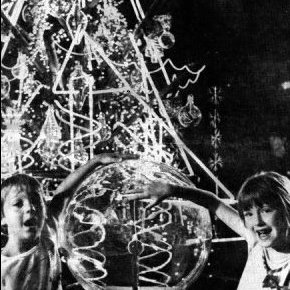
Kids interact with plasma (The Australian)
The tree is shaped by more than 100 lineal metres of hand-worked glass. It stands over 4 metres (14 ft) high and is more than 5 metres (16 ft) wide.
The decorations are filled with gases such as argon, xenon, krypton, neon and helium.
When the gases are activated, they cause the decorations to glow and flash. When touched, they activate choral voices so the tree can sing in rich harmonious tones.

Ionised neon glow lamp:
Many of the decorations have no electrical connection; these displays are activated by the proximity of the visitor which affects the conductivity of the gases in the glass decorations.
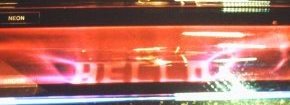
Induction powered touch tubes:
Visitors to the museum create their own plasma effects by being in proximity to an/or touching the glass tubing and displays decorating the tree.

Ionised gas plasma trails:
Behind its dazzling decorations is the most common state of matter in the universe: Plasma. When energy is introduced into a gas, electrons are separated from the atoms and molecules to become positively charged ions.
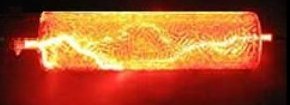
Neon crackle tube example:
These charged ions go to make up the plasma. During the excitation process, electromagnetic radiation (such as visible light) is given off, resulting in the dramatic effects of the ionised Christmas tree.
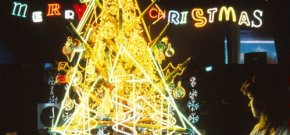
A whirling maelstom of ionisation:
The decorations have been hand worked and blown into electronic icicles, plasma baubles, snowflakes, double helix argon spirals and many other gas discharge displays.
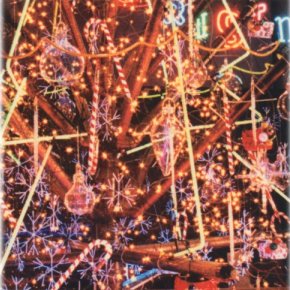
Some of the displays were hand-blown by traditional craftsmen to designs based on early nineteenth century Christmas Tree decorations.
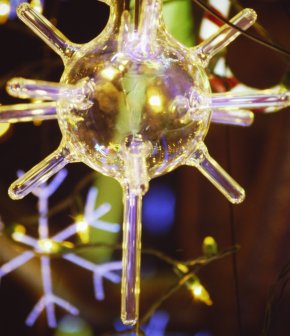
Hand blown glass plasma decorations:
As if that weren't enough, electronic sensing devices monitor the gas discharges for any changes caused by visitor interaction.
Information about changes is fed back to central control units. In this way, visitors control the sound & lighting effects - both by proximity & direct interaction with the tree decorations.
The tree produces a full range of rich choral harmonies and a variety of accompanyments including wind chimes and bamboo flutes.
The sounds are stored in a modified KORG M1 synthesiser whilst other computerised equipment controls changes in pitch, decay and other sound properties.
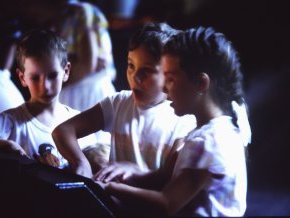
Molecular machines jamming with plasma:
Another control unit monitors three large plasma touch panels at the base of the tree. This control unit makes sure that the variuos different sounds always blend together harmoniously - avoiding poor combinations of voices in different pitches.
Examples of actual sound compositions
Dr Jesse Shore, Science Currator at The Powerhouse Museum, commissioned a Sydney design group, the Studio of Arts And Sciences, Sydney, to design and create the tree.
In the words of Doctor Shore:
'The tree shows how a marriage of Art and Science can produce a truly wonderful experience for all.'
Definitely a MUST to take the kids to this Christmas - both young and old!
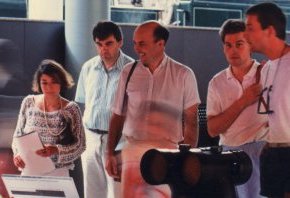
Older kids can have fun too:
The text for most of this article was taken verbatim from an article in The Australian newspaper.
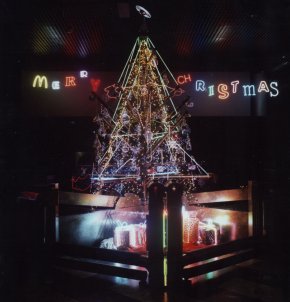

3D cardboard cutout - kids souvenir:
Korg M1 keyboard - Example Sounds:
Bill Parker plasma ball at Powerhouse Museum:
Symphony of Science: We are all connected
The beauty of a living thing is not the atoms that go into it but the way those atoms are put together: Carl Sagan
Comments
Prior to the launch of the exhibition, the Studio of Arts And Sciences designed an educational DIY kit that allowed electronics hobbyists to build their own experimental plasma device: The Poor Mans Plasma Display was published in Australia by Silicon Chip Magazine: Plasma Display EHT Generator SC0820888 by Leo Simpson (kits were distributed in Australia by Jaycar - Gary Johnston).
Silicon Chip can supply back issues or photostat copies of this article for $7.70 each, including postage.
Most tree decorations were powered by simple, single transistor EHT power supplies similar to http://bogard.110mb.com/plasmaglobecircuit.htm The circuit is effectively a high frequency, solid state Tesla coil using a flyback transformer from an old television set. Having lots of tesla coils in a combined space creates lots of stray RF. This allows displays to be activated solely by proximity - see example video clip using flouro lights
The theremin: the instrument you play without touching: How it works: inside the theremin's circuitry guts, two radio frequency oscillators produce two distinct signals. It's the mixing of these two signals in a process called heterodyning that create the sounds. The performer stands near the unit and controls the pitch and volume by moving their hands in the vicinity of the two antennas. Generally, the left hand controls the volume over the looped antenna, and the right hand the pitch near the straight antenna (reverse the antennas for left-handed v right-handed player).
Changes in pitch and volume are controlled by the performer moving his or her hands nearer or farther from their respective antenna. In Kurstin's case, the closer her left hand moves towards the straight antenna, the higher the pitch in tone, while the farther her right hand moves from the looped antenna, the louder the volume. Musical techniques such as vibrato and staccato can be mastered and controlled by rapid hand movement
More information here: http://www.sciencebuzz.org/blog/theremin-instrument-you-play-without-touching And how you might use it: http://www.youtube.com/watch?v=X-ywH1Vj8_U&feature=player_embedded
Adding tiny amounts of secondary gases (examples are bromine, and iodine) helps ionize the main gas mix (also known as 'doping' and widely used in semiconductor manufacture). The energy is raised to a higher level so that the light emitted is brighter and a slightly different/more intense color than it would otherwise be. Varying the frequency and wave-form applied to the chamber can also have very dramatic effect on the characteristics of the display.
Although Rutherford and others had experimented and noted the similar effects, Bill Parker is the originator/inspiration behind most modern plasma display technology.
As is often the case in the annals of invention, Bill Parker dreamed up the product for which he is famous after a fortuitous mishap in the lab. An undergraduate at the time, Parker was in his physics lab at Massachusetts Institute of Technology late one night in 1971 experimenting with gaseous fuels for electrical rocket engines when he developed the concept of the plasma globe. He accidentally left a valve open, filling his test chamber with neon and argon?which he had been ionizing in his experiments to create rocket thrust?to a higher pressure than usual. This time, when he applied a voltage, visible plasma formed. "I had these colored streamers climbing all over the surface of the engine," Parker remembers. "That same night, I took a glass ball, put a little of the gases inside," hooked it up to a power supply, "and took it to my girlfriend's house for a party she was having."
It wasn't until three years later, when he was an artist-in-residence at the Exploratorium, a museum of science and art in San Francisco, that Parker put the first serious plasma globe on display. The museum "wanted me to do exhibits to help people understand electricity", he says. With its electrode-generated streams of dancing light, the glass sphere Parker had previously used for party entertainment fit the bill. http://pubs.acs.org/cen/whatstuff/86/8643sci3.html